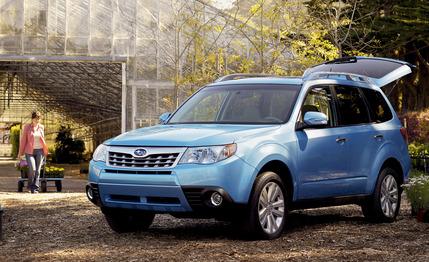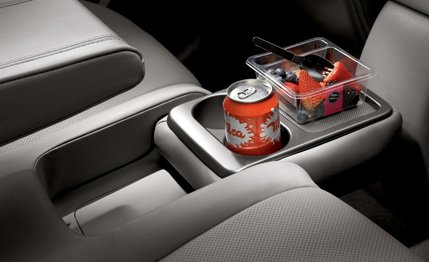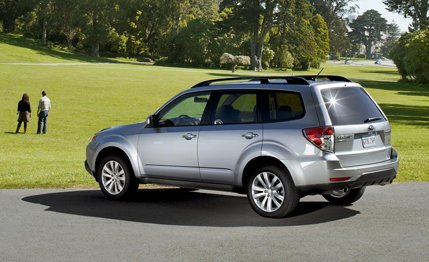 Short Take Road Test
Short Take Road Test
What Is It?

Starting with the 2011 model year, Subaru quietly introduced its third-generation flat-four, called the FB25, in the Forester 2.5X. (The turbocharged four in the 2.5XT is still the old EJ25.) The FB25 makes the same 170 hp as the EJ, but torque is up 4 lb-ft to 174. A gain of 4 lb-ft isn’t the only reason Subaru redesigned the engine. The new four is slightly more efficient—EPA ratings for our four-speed-automatic test car jump 1 mpg in each test to 21 city and 27 highway—saves weight, and paves the way for the future adoption of direct injection.
How Does It Drive?
Dynamically, the Forester is basically unchanged, which means the entry-level SUV/crossover/wagon behaves more like a car than its tall roofline would suggest, with no excessive roll or understeer. Our skidpad was covered in snow, preventing us from measuring lateral acceleration, but we suspect the updated Forester will turn with nearly identical gusto to the 2009 model, which hung on for 0.79 g.
We did, however, note an appreciable improvement in acceleration times. The old, EJ-powered 2.5X dawdled its way to a 9.7-second 0-to-60-mph time and a bury-your-head-in-the-sand 17.4-second quarter-mile. With the FB burning, the 2011 model is a full second quicker to 60 mph and shaves 0.6 second off the quarter-mile, downgrading that gripe to “nothing to brag about” and upgrading the ET to 16.8 seconds.

But excellent sightlines, comfortable front seats, and standard four-wheel drive entice buyers into the Forester, so most drivers will never realize their car isn’t quick. They might, however, notice the boat-anchor four-speed automatic. Its shifts aren’t slow or unsmooth, but the shortage of ratios means the engine is often spinning faster than you might expect, and some of the kickdowns are startling. It’s a very different experience from the six-, seven-, and eight-speed autos of the modern era. Our observed fuel economy, despite slightly better EPA ratings, was unchanged from the older engine’s 20 mpg.
How Does It Stack Up?
A new engine in the Forester does not disrupt the small-SUV pecking order. About a year ago, we pitted a Forester 2.5XT (the more powerful turbo, mind you) against seven other small utes. In that test, the Forester finished fourth behind a Toyota RAV4, Volkswagen Tiguan, and Honda CR-V. As with this naturally aspirated example, we loved the comparo Forester’s carlike handling and driver comfort and loathed the four-speed. Had we compared a 170-horse example, the Forester might have slipped a place or two, although its agility and manners still set it apart from the bottom half of the segment (the Mitsubishi Outlander, the GMC Terrain/Chevrolet Equinox, and the Ford Escape).
What’s the Cost?
A base Forester 2.5X starts at $21,220. Even with the $1200 automatic, the Forester starts roughly $1500 below the cheapest four-wheel-drive Honda or Toyota, and it is more than $5000 less than the cheapest four-wheelin’ Tiguan. On the other hand, Kia’s Sportage starts at $22,490 with all-wheel drive, and it offers more power and slightly better fuel economy.
The top-rate Touring trim like that tested here is more dear, requiring another $6300. It adds HID headlights, a panoramic sunroof, leather seats, an upgraded stereo, and various other trim bits. The only other option on our car was a $48 cargo net. Interestingly enough, if you live in a CARB state, getting a PZEV Forester inflates the window sticker by $300—many manufacturers upgrade their cars to PZEV at no additional cost. Still, with the Forester’s low base price and so much inherent goodness, that’s $300 we can shrug off.
